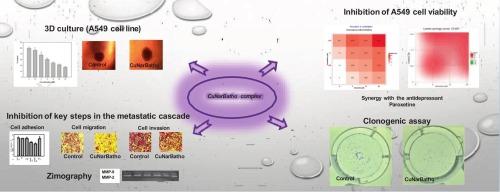Influence of Bathophenanthroline in Cu-Naringenin complexes on 3D culture anticancer activity, antimetastatic properties and synergy with the antidepressant paroxetine
IF 3.2
2区 化学
Q2 BIOCHEMISTRY & MOLECULAR BIOLOGY
引用次数: 0
Abstract
Cancer is responsible for about 22.8 % of global deaths from noncommunicable diseases, with lung cancer the most diagnosed in 2022. Non-small cell lung cancer (NSCLC) accounts for 85–90 % of cases. Conventional treatments like chemotherapy have limitations, including low bioavailability and drug resistance. Drug repositioning, where existing medications are used for new purposes, has emerged as a promising approach. This study advances the understanding of antitumor effects of the copper-naringenin (Cu-Nar) complexes: CuNar, CuNarPhen, CuNarBatho [CuNarPhen and CuNarBatho feature CuNar containing phenanthroline (Phen) or bathophenanthroline (Batho)] in lung cancer cells (A549). Clonogenic assays in 2D cultures showed that CuNarBatho was the most effective complex in inhibiting colony formation. Likewise, in a 3D culture model, CuNarBatho disrupted tumor spheroids and demonstrated significant cytotoxicity, with an IC50 value of 11.72 μM. The effect on metastatic processes was also studied, revealing that the complexes significantly reduced cell migration, adhesion, and invasion, particularly CuNarBatho. Zymography assays showed that this complex inhibited the activity of matrix metalloproteinases (MMP-2 and MMP-9), key enzymes involved in cancer metastasis. Additionally, the cytotoxic effects of the three complexes in combination with the antidepressant agent paroxetine, a selective serotonin reuptake inhibitor, were studied, and its inhibitory effect in A549 cells was also determined. When paroxetine and the copper complexes were combined, different degrees of synergy were observed, with CuNarBatho exhibiting the most impactful synergistic effect. These findings suggest that CuNarBatho has potential as a novel therapeutic strategy for lung cancer.

铜-柚皮素配合物中邻菲罗啉对三维培养抗癌活性、抗转移特性及与抗抑郁药帕罗西汀协同作用的影响
癌症占全球非传染性疾病死亡人数的22.8%,其中肺癌在2022年被诊断出最多。非小细胞肺癌(NSCLC)占85% - 90%的病例。像化疗这样的传统治疗有局限性,包括低生物利用度和耐药性。药物重新定位,即将现有药物用于新的目的,已经成为一种很有前途的方法。本研究进一步了解了铜-柚皮素(Cu-Nar)配合物:CuNar、CuNarPhen、CuNarBatho [CuNarPhen和CuNarBatho以含有邻菲罗啉(Phen)或邻菲罗啉(Batho)]的CuNar在肺癌细胞中的抗肿瘤作用[A549]。2D培养的克隆实验表明,CuNarBatho是抑制菌落形成最有效的复合物。同样,在3D培养模型中,CuNarBatho破坏肿瘤球体并表现出显著的细胞毒性,IC50值为11.72 μM。对转移过程的影响也进行了研究,揭示了复合物显着减少细胞迁移,粘附和侵袭,特别是CuNarBatho。酶谱分析表明,该复合物抑制基质金属蛋白酶(MMP-2和MMP-9)的活性,而基质金属蛋白酶是参与肿瘤转移的关键酶。此外,研究了这三种复合物与抗抑郁药帕罗西汀(一种选择性5 -羟色胺再摄取抑制剂)联合使用时的细胞毒作用,并测定了其对A549细胞的抑制作用。当帕罗西汀与铜配合物结合时,观察到不同程度的协同作用,以CuNarBatho表现出最显著的协同作用。这些发现表明,CuNarBatho有潜力成为一种新的肺癌治疗策略。
本文章由计算机程序翻译,如有差异,请以英文原文为准。
求助全文
约1分钟内获得全文
求助全文
来源期刊

Journal of Inorganic Biochemistry
生物-生化与分子生物学
CiteScore
7.00
自引率
10.30%
发文量
336
审稿时长
41 days
期刊介绍:
The Journal of Inorganic Biochemistry is an established international forum for research in all aspects of Biological Inorganic Chemistry. Original papers of a high scientific level are published in the form of Articles (full length papers), Short Communications, Focused Reviews and Bioinorganic Methods. Topics include: the chemistry, structure and function of metalloenzymes; the interaction of inorganic ions and molecules with proteins and nucleic acids; the synthesis and properties of coordination complexes of biological interest including both structural and functional model systems; the function of metal- containing systems in the regulation of gene expression; the role of metals in medicine; the application of spectroscopic methods to determine the structure of metallobiomolecules; the preparation and characterization of metal-based biomaterials; and related systems. The emphasis of the Journal is on the structure and mechanism of action of metallobiomolecules.
 求助内容:
求助内容: 应助结果提醒方式:
应助结果提醒方式:


